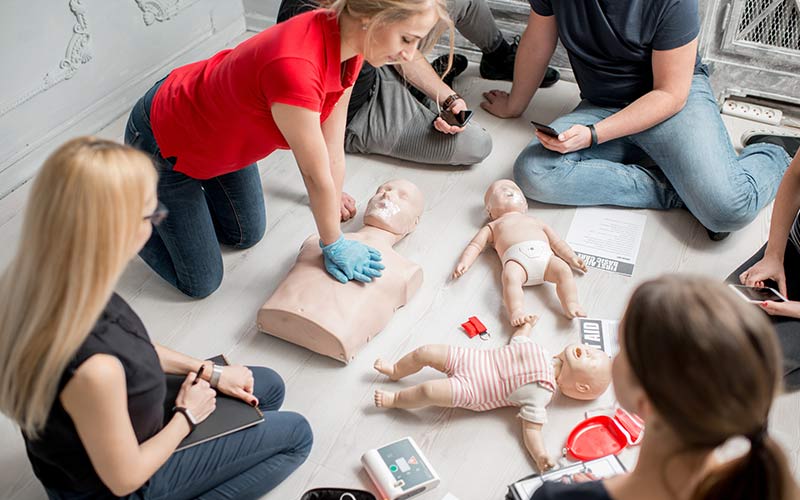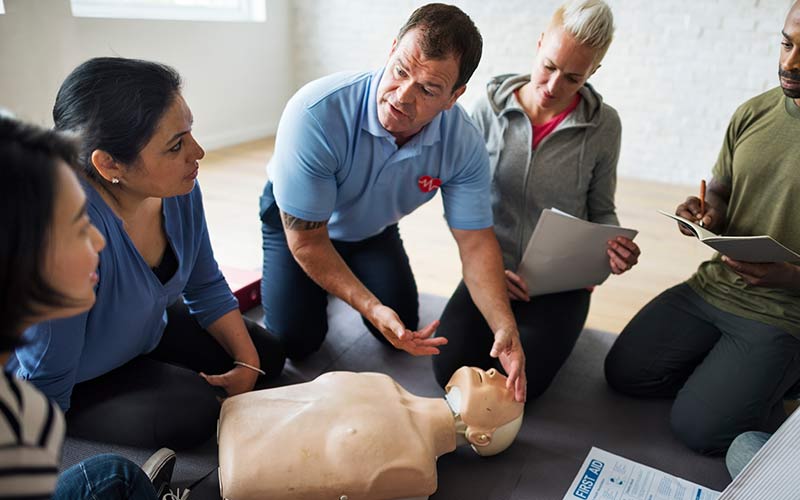There’s no question that those who work in the healthcare sector need to undergo CPR training. However, they’re not the only ones who can benefit from such knowledge. In fact, as many people as possible should have such training, and a community CPR training program can help.
Why Is CPR Important to the Community?
When someone suffers from cardiac arrest, the heart stops beating. Without intervention, death can occur within minutes. CPR, or cardiopulmonary resuscitation, is the best way to intervene in such a situation. In fact, if administered immediately, CPR can double or triple the victim’s chances of survival.
This is because CPR is meant to keep blood flowing – even partially. Doing so helps bring oxygen to the different parts of the body, including the brain. This helps prevent further damage to the body and improves the chances that medical staff will be able to resuscitate the patient.
Why Is CPR Training Necessary?
CPR is one of the critical steps or links in the American Heart Association’s Chain of Survival. Currently, there are two commonly known versions of CPR.
The first one is what healthcare workers learn and is a combination of chest compressions and mouth-to-mouth breathing. This is typically performed at a ratio of two breaths for every 30 compressions.
The second version of CPR is what the general public should know in case they see someone suddenly collapse. Also called hands-only CPR, it relies only on chest compressions.
However, you may wind up doing too few chest compressions or not pumping the chest hard enough. That’s why undergoing training is so important. With the proper training, you learn what you’re supposed to do and how to do it correctly.
Here are a few other reasons why CPR training is needed.
CPR is Easy to Learn
Sadly, not many people know that CPR doesn’t rely on deep medical knowledge. The truth is, you don’t need to know exactly how the heart works in order to save a life. A community CPR training program will help you learn what you need so you can provide assistance when needed.
Training Improves Confidence

Have you ever found yourself in a crowd just watching someone fall unconscious while their companions call for help? CPR training will give you the confidence to help the next time you witness a medical emergency.
Remember: it’s not enough to just watch a TV show that sometimes depicts people performing CPR. You need to undergo proper training to know exactly what to do in such situations.
Community CPR Training Program is Beneficial for Many
It’s not just paramedics, nurses, doctors, and other healthcare workers who will benefit from knowing how to perform CPR. No matter what sector you work in, CPR is a very useful skill to have.
For example, you might see a passenger on a flight pass out and quickly become unresponsive. Whether you’re a fellow passenger or a flight attendant, you can use CPR to help the unconscious individual.
Or you’re a daycare worker, and a colleague or one of the children you’re looking after suddenly collapses. Administering CPR will help keep their blood pumping, bringing oxygen where it needs to go.
CPR Prevents Disabilities
CPR focuses on keeping blood flowing throughout the body. This helps to lower the risk of disability, such as what could happen if the brain is oxygen-starved for too long.
Therefore, knowing CPR won’t just help you assist others if they suffer from cardiac arrest. It can also help ensure that these people will still have a high quality of life afterward.
CPR Saves Lives
Not all instances of cardiac arrest happen inside the hospital; in fact, the majority of them happen outside. There’s nothing wrong with calling an ambulance, of course. But if you don’t do anything besides sitting and waiting, the patient could slip away before you realize it.
On the other hand, if you provide CPR within the first few minutes of a cardiac arrest, you can help increase the patient’s chances of survival. That’s why it’s crucial that as many people as possible learn this vital skill.
Community CPR Training Program in Your HOA and More

Each year, more than 350,000 people in the U.S. experience a sudden cardiac arrest while outside the hospital. 4 out of 5 of these SCAs happen in the home. If you knew you could use CPR to help save the life of a loved one, wouldn’t you want to learn the skill?
If so, the big question you’re likely facing would be how to bring the CPR training program in your community.
The AHA actually offers community programs geared towards helping certain demographics learn at least hands-only CPR. For example, they have “CPR in Schools” and “Be the Beat”, both programs focused on bringing CPR to schools and universities.
The first program helps students learn the life-saving skills of CPR, AED (automated external defibrillator) use and choking relief. The second is geared towards teachers and school administrators but focuses on the first two skills.
But what if you want to bring the training to, say, your neighborhood? Well, some HOAs hold CPR training sessions, increasing or decreasing the number of sessions according to demand. Find out if your HOA offers this training, and get other homeowners to join you.
If your neighborhood or area doesn’t have an HOA, you can still start a community CPR training program. The AHA has many resources you can use to help you get started. And once you know what to do, you can help others learn, too.
How to Improve Community CPR Training Program
If you want to start a CPR training program, you’ll also want to ensure that those who join really will intervene during a cardiac emergency. Here are a few tips to help you improve the odds of trainees offering to help.
1. Keep It Simple. As mentioned above, bystanders don’t need the medical knowledge or details that card-carrying healthcare providers have. So simplify the CPR training you provide and focus on hands-only CPR.
2. Use Engaging Training Methods. If you keep trainees engaged throughout the learning process, you can boost how much info they retain. Uniformity is important, so don’t forget about standardized methods of teaching CPR (e.g. videos).
However, you need to use hands-on practice, too, to increase trainees’ attention and help them improve their performance. To do this, you can use learning apps and immediate CPR feedback devices, making learning more tangible and engaging.
3. Collaborate with Existing Initiatives. Whether you want to reach more trainees or want to have access to formal training, collaborating with an existing initiative can help.
Besides an HOA, you can reach out to local police and fire departments and see if they have an existing community CPR training program. Participating in such programs can help you refresh your own skills and will help trainees get the formal training they need.
CPR and the Community

Learning CPR is voluntary, but as you can see, CPR training is incredibly important for any community. Even if you don’t have to use it to help a loved one, you can keep another person from losing someone dear to them.
So it doesn’t matter whether you start a community CPR training program and encourage others to learn or join an existing program and get other homeowners to do the same. You may lose time because of the training, but gaining the ability to help save someone’s life is priceless.
You Can Also Read These:
- How To Create A Neighborhood Watch For Added Security
- How To Volunteer At A Local Red Cross As An Individual And As A Community
- Bond With Food: How To Start Community Cooking Sessions In Your HOA




